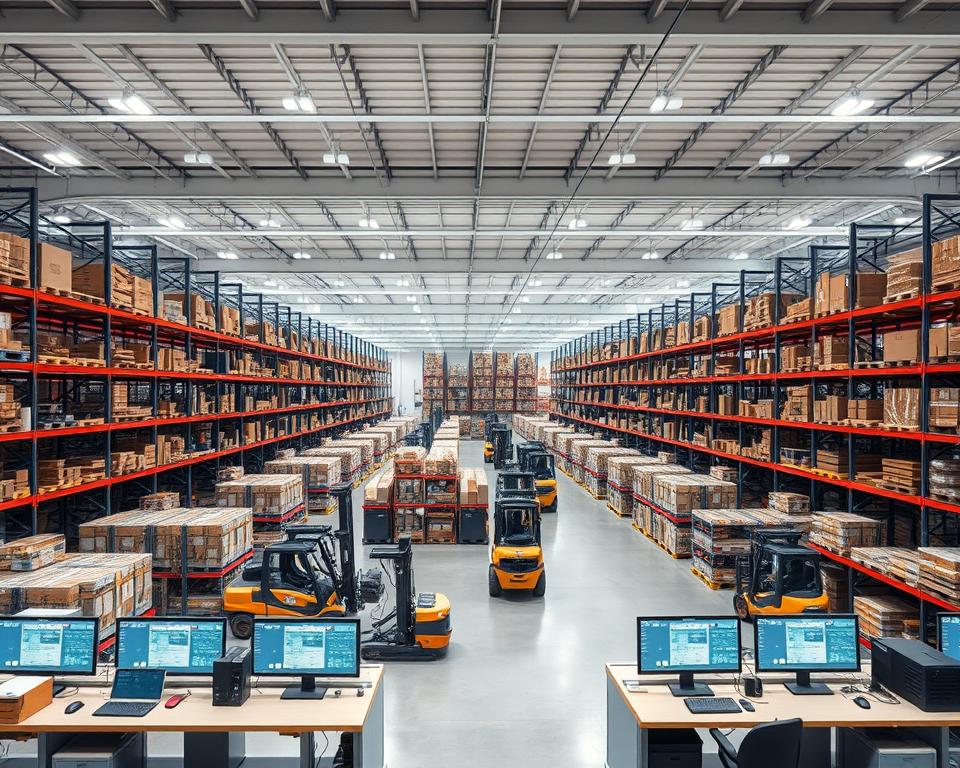A warehouse management system is key for businesses to make their logistics smoother. It helps in automating logistics, cutting down on mistakes, and boosting efficiency. To learn more about building a data warehouse from scratch, visit warehouse management system development.
Creating a warehouse management app like ShipBob needs careful planning and action. It involves making a system that can handle logistics, manage inventory, and process orders well.
Table of Contents
Key Takeaways
- Implementing a warehouse management system can improve logistics automation and order fulfillment
- A scalable and efficient warehouse management system is crucial for businesses
- Logistics automation can reduce errors and increase efficiency
- A warehouse management app like ShipBob can handle inventory management and order processing
- Developing a warehouse management system requires careful planning and execution
- Streamlining logistics and improving order fulfillment can increase customer satisfaction
Understanding the Warehouse Management System Market
The warehouse management market is growing fast. This is because more people are shopping online and need better logistics. Warehouse management apps help businesses work better and stay ahead in the logistics world.
The market size and growth are big, with global numbers expected to rise. This growth comes from new WMS trends like cloud solutions, AI, and IoT. Big players in WMS are spending a lot on research to lead the market and meet the demand for better logistics.
There are a few ways warehouse management apps make money:
- Subscription-based models
- Transaction-based models
- Advertising and sponsored content
In summary, the warehouse management system market is booming. It’s driven by online shopping and the need for efficient logistics. Knowing the market size, growth, and key players helps businesses make smart choices for their logistics. This way, they can stay competitive in the logistics world.
| Company | Revenue Model | Monetization Strategy |
|---|---|---|
| Company A | Subscription-based | Monthly subscription fees |
| Company B | Transaction-based | Per-transaction fees |
| Company C | Advertising | Sponsored content and ads |
Core Features of a ShipBob-like Warehouse Management App
Creating a warehouse management app like ShipBob requires key features. These include inventory management, order fulfillment, and shipping integration. These are vital for success.
Managing inventory is a crucial part of the app. It tracks stock levels and updates inventory automatically. This helps avoid stockouts and overstocking, saving space.
The app should also focus on order fulfillment. It should process and ship orders fast and accurately. This ensures customers get their products on time. Combining order fulfillment with inventory management boosts shipping efficiency and cuts down on errors.
- Automated inventory tracking
- Real-time stock updates
- Order processing and shipping integration
- Barcode and QR code scanning
- Customizable reporting and analytics
These features help businesses run better, make customers happier, and grow their profits. By focusing on inventory management, order fulfillment, and shipping, businesses can make their warehouse management smooth and efficient.
| Feature | Description |
|---|---|
| Inventory Management | Track stock levels, monitor product movement, and automate inventory updates |
| Order Fulfillment | Process and ship orders quickly and accurately, ensuring timely delivery to customers |
| Shipping Integration | Integrate with shipping carriers to streamline the shipping process and reduce errors |
Essential Technology Stack for WMS Development
Building a warehouse management system (WMS) needs the right technology stack. TigerGraph, a leading graph database company, stresses picking the best technology stack. A good WMS technology stack boosts efficiency, cuts costs, and makes customers happier. To get this, you need to think about frontend technologies like React or Angular for a smooth user experience.
Choosing the right backend frameworks, like Node.js or Ruby on Rails, is also key. These frameworks help build a strong and growing system. Scalability is vital in WMS development. It lets the system handle more data and users as the business grows. The right backend frameworks ensure your WMS can meet these demands.
Database architecture is another important part of the WMS technology stack. A good database design improves data handling, cuts down errors, and boosts system performance. Popular databases for WMS include MySQL, PostgreSQL, and MongoDB.
Key Considerations for WMS Technology Stack
- Scalability and performance
- Security and compliance
- Integration with third-party services
- Cost and ROI
By carefully looking at these points and picking the right WMS technology stack, businesses can create a strong and efficient system. This system meets their specific needs and supports long-term success.
Planning Your Development Timeline
Creating a warehouse management app needs a solid WMS development timeline. You must define the project scope, estimate how long it will take, and make a schedule. Good project planning makes sure the app’s logistics software works well.
A good timeline avoids delays and keeps costs in check. It lets the team focus on the app’s most important parts. By breaking tasks into smaller steps and setting realistic deadlines, the app will meet standards and be ready on time.
When planning a WMS development timeline, consider these points:
- Define the project scope and needs
- Guess how long it will take and what resources you’ll need
- Make a detailed schedule and timeline
- Find and solve potential problems
By planning well, developers can make a warehouse management app that works great. It will meet user needs and improve logistics.
| Development Phase | Timeline | Key Activities |
|---|---|---|
| Planning and Scope Definition | 2-4 weeks | Define project scope, estimate development time, and create project schedule |
| Design and Prototyping | 4-6 weeks | Design user interface, create prototypes, and test with users |
| Development and Testing | 12-16 weeks | Develop app features, conduct unit testing, and perform integration testing |
Designing the User Interface and Experience
A good WMS user interface is key for a smooth experience. It’s important to think about what users need. This includes warehouse managers, inventory managers, and logistics staff. A user-friendly interface boosts productivity, cuts down on mistakes, and makes things more efficient.
The logistics software design should focus on being simple, clear, and easy to use. This means using easy-to-follow navigation, clear labels, and short instructions. A tidy dashboard gives users a fast look at important info like inventory levels, order status, and shipment tracking.
Dashboard Layout Considerations
- Customizable widgets and modules
- Real-time data updates
- Personalized user profiles
Inventory Management Interface
A good inventory management interface helps users find and manage stock fast. It lets them track stock levels and make the most of storage space. This is done with tools like barcode scanning, automatic tracking, and alerts for low stock.
| Feature | Description |
|---|---|
| Barcode Scanning | Quickly identify and track inventory using barcode labels |
| Automated Inventory Tracking | Real-time updates on inventory levels and stock movements |
| Low-Stock Alerts | Receive notifications when inventory levels reach a certain threshold |
Order Processing Screens
Fast and accurate order processing is vital for on-time shipments. A well-made order screen helps users quickly handle orders, print labels, and track shipments. It uses tools like automated routing, real-time updates, and customizable shipping options.
Building the Core Functionality Modules
Creating the core modules of a warehouse management app is key for good inventory management and order fulfillment. A well-made WMS core helps businesses run smoother, save money, and make customers happier.
One important part of WMS core is working with third-party services. This makes order and shipping processes smooth. It also lets everyone track things in real-time and keeps everyone updated.
Some must-have features of WMS core are:
- Inventory tracking and management
- Order processing and fulfillment
- Shipping integration and tracking
These features together make a complete warehouse management solution. They help businesses run better and make more money.
By focusing on strong core modules, businesses lay a solid base for their app. This ensures they manage inventory, fulfill orders, and integrate shipping well. This helps them serve customers better, leading to growth and success.
Implementing Inventory Tracking Systems
Effective inventory management is key for a warehouse app, and inventory tracking systems are essential. By using barcode scanning and QR codes, businesses can track inventory better and cut down on mistakes.
Some main advantages of using inventory tracking systems include:
- Improved accuracy and efficiency
- Real-time stock updates
- Enhanced inventory forecasting capabilities
These technologies help businesses manage their inventory better. This leads to making smarter decisions for growth and profit.
| Inventory Tracking Method | Benefits |
|---|---|
| Barcode Scanning | Improved accuracy, reduced errors |
| QR Code Integration | Enhanced inventory forecasting, real-time stock updates |
By using inventory tracking systems and barcode scanning and inventory forecasting, businesses can stay ahead in the market. This leads to long-term success.
Security Measures and Compliance Requirements
When making a warehouse management app, WMS security and data protection must be top priorities. It’s important to use strong security to keep sensitive info safe. This means encrypting data both when it’s moving and when it’s stored.
It’s also key to do regular security checks. This helps find and fix any weak spots before they can be used by hackers. By using third-party logistics (3PL) companies, businesses can tap into their warehouse management skills. They also get to use the 3PL’s strong security setup.
Data Protection Protocols
- Encryption of sensitive data
- Access controls, including multi-factor authentication
- Regular security audits and penetration testing
Industry Standards Compliance
Following industry standards like GDPR and HIPAA is crucial. It shows that a business is serious about keeping data safe. This helps keep customer trust high.
Integration with Third-party Services
Connecting with shipping carriers, payment gateways, and accounting software is key for a top-notch warehouse management app. WMS integration lets different systems talk to each other smoothly. This cuts down on mistakes and boosts efficiency.
Using APIs and webhooks for integration means data flows in real-time. This helps businesses adapt fast to market changes. It also makes customers happier and boosts sales. The main perks of working with third-party services are:
- Automated shipping and tracking
- Secure payment processing
- Accurate inventory management
- Streamlined accounting and invoicing
With WMS integration and APIs, companies can concentrate on what they do best. This means better inventory management, order processing, and supply chain optimization. It drives growth, increases profits, and keeps businesses ahead in the market. As the need for efficient warehouse management grows, so will the need to integrate with third-party services.
Testing and Quality Assurance Protocols
When making a warehouse management app, quality assurance is key. It makes sure the app works right. This includes WMS testing and unit testing. These tests find and fix bugs, security issues, and performance problems.
Performance testing is also important. It checks how fast, scalable, and reliable the app is. This ensures the app can handle lots of users and data well. It’s vital for a good user experience.
- Improved app reliability and stability
- Enhanced security and data protection
- Better user experience and satisfaction
By using unit testing and other tests, developers can make sure their app is top-notch. This leads to more users and happier customers.
| Testing Type | Description |
|---|---|
| Unit Testing | Tests individual components of the app |
| Performance Testing | Evaluates the app’s speed, scalability, and reliability |
| User Acceptance Testing | Verifies the app meets user requirements and expectations |
Deployment and Maintenance Strategies
Choosing how to deploy a warehouse management system (WMS) is crucial. Options include cloud hosting, on-premise, and hybrid. Each has its pros and cons, depending on your business needs. For instance, cloud hosting is great for scalability, while on-premise gives you more control over data and security.
Keeping your WMS running smoothly is key. This means regular updates, backups, and troubleshooting. You can use automated and manual methods to keep things running well. Good maintenance strategies help avoid downtime, cut down on errors, and boost system performance.
The perks of cloud hosting for WMS include:
- Scalability and flexibility
- Cost savings on infrastructure and maintenance
- Enhanced security and data protection
Cloud hosting also lets businesses quickly test and deploy new apps. This is great for staying competitive.
By weighing your options and maintenance strategies, you can get a WMS that fits your needs. Whether it’s cloud hosting or on-premise, the goal is to find a balance. This balance should consider cost, scalability, and security for long-term success.
| Deployment Option | Advantages | Disadvantages |
|---|---|---|
| Cloud Hosting | Scalability, flexibility, cost savings | Dependence on internet connectivity, security concerns |
| On-Premise Deployment | Control over data and security, customization options | Higher upfront costs, limited scalability |
Cost Analysis and ROI Projections
When making a warehouse management app, it’s key to do a detailed cost analysis. This includes looking at development costs, operational expenses, and the expected return on investment. By figuring out the break-even point and ROI projections, businesses can make smart choices about their investment.
Understanding the development costs is a big part of the cost analysis. This includes the cost of designing and building the app, plus the cost of implementing and integrating the technology. Development costs can change a lot based on the app’s complexity and the technology used.
Some important things to think about when looking at development costs are:
- Technology stack and infrastructure needs
- Development team size and who’s on it
- Testing and quality assurance steps
Businesses also need to think about operational expenses, like maintenance and support costs, and any ongoing fees for third-party services. By carefully looking at these costs and projecting ROI, businesses can make a detailed cost analysis. This helps them make smart decisions about their investment.
By doing a thorough cost analysis and making accurate ROI projections, businesses can make sure their warehouse management app is both useful and profitable. This means carefully looking at development costs, operational expenses, and expected return on investment. This gives a full picture of the app’s financial impact.
Conclusion
Creating a warehouse management app like ShipBob is a big task. It needs careful planning, execution, and upkeep. A good warehouse management app makes logistics smoother, improves inventory, and boosts efficiency. As the need for logistics software grows, businesses must keep up to stay ahead.
In today’s fast-paced logistics world, a strong WMS conclusion is key for smart decisions. Using technology and data analytics helps businesses improve their supply chain. This leads to lower costs and happier customers. Looking ahead, technology will be even more vital in the warehouse management field.
Investing in a warehouse management app can give businesses an edge. The right logistics software lets companies focus on growing, innovating, and pleasing customers. As the logistics field keeps changing, the role of WMS conclusion will keep growing too.


















